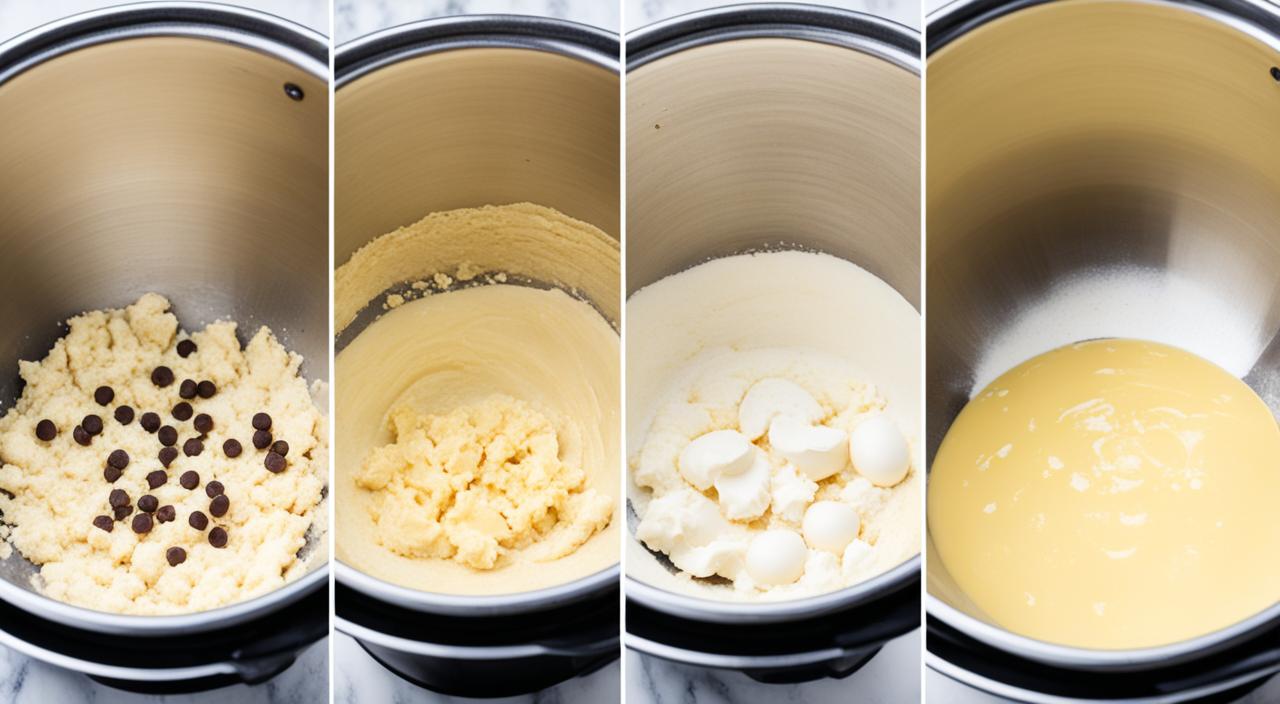Picture this: a warm, freshly baked batch of cookies straight from the oven. The aroma fills the kitchen, the anticipation builds, and you can’t wait to take that first delicious bite. We all yearn for that moment of pure cookie bliss, where the texture is just right, and the flavor is heavenly.
But how do you achieve cookie perfection? It all starts with the mixing process. Yes, my friend, the way you mix your cookie dough can make all the difference in the world. And today, I’m going to share with you the three main methods of mixing cookie biscuits that will transform your baking game.
These techniques have been tried and tested by bakers around the globe, and they are guaranteed to take your cookies from good to exceptional. So, gather your ingredients, put on your apron, and let’s dive into the world of cookie mixing.
The Creaming Method
The creaming method is a popular technique used to mix biscuit dough for cookies. It involves properly incorporating the butter and sugar to create a light and fluffy dough. Here’s how:
- Step 1: Begin by ensuring that your butter is at room temperature. This will make it easier to blend with the sugar.
- Step 2: In a mixing bowl, combine the softened butter and granulated sugar.
- Step 3: Using an electric mixer or a stand mixer fitted with a paddle attachment, beat the butter and sugar together on medium speed until creamy and well combined.
- Step 4: Gradually add in any flavorings, such as vanilla extract or citrus zest, and beat until incorporated.
- Step 5: Add the eggs, one at a time, beating well after each addition. This helps to ensure a smooth and homogenous dough.
- Step 6: Finally, gradually add in the dry ingredients, such as flour, baking powder, and salt. Mix on low speed until just combined.
Remember to scrape down the sides of the bowl as needed to ensure all ingredients are well incorporated.
Using the creaming method allows the butter and sugar to form small air pockets, resulting in a light and tender cookie. It is important to avoid overmixing the dough, as this can lead to a denser texture. By following these steps, you can achieve the perfect biscuit dough for your cookies.
For a visual representation of the creaming method, refer to the following image:
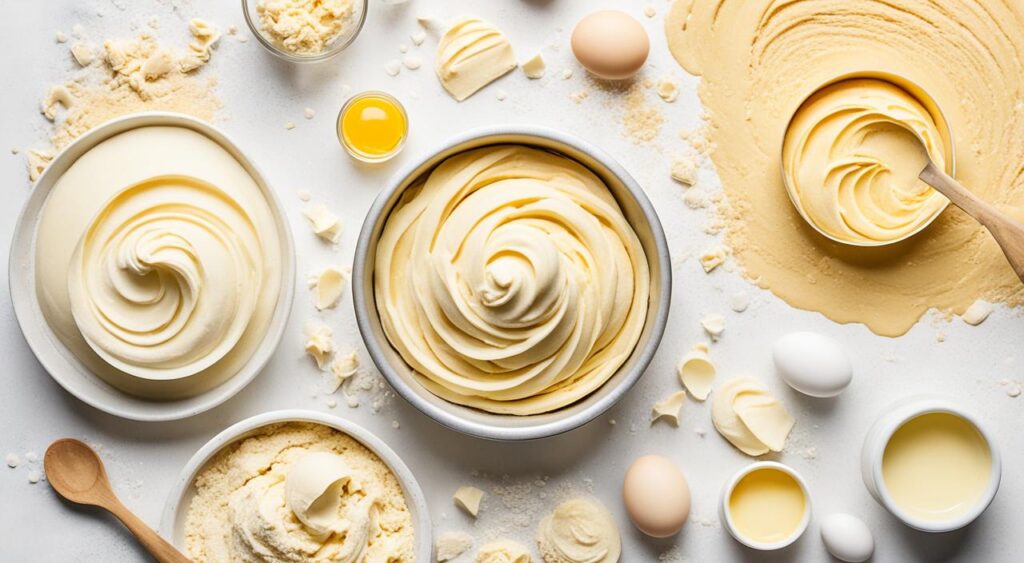
The creaming method creates a light and fluffy texture in cookies by incorporating air into the dough through the creaming of butter and sugar.
The All-in-One Method
The all-in-one method is a convenient and straightforward approach to mixing cookie dough. Unlike other methods that require specific steps and separate mixing of ingredients, the all-in-one method allows you to combine all the necessary ingredients together at once.
This method is especially beneficial for those looking for fast and easy cookie preparation. It eliminates the need for extra bowls and multiple mixing stages, streamlining the entire process.
With the all-in-one method, you can simply gather all the required ingredients and mix them together until well combined. This ensures that the flavors meld together evenly, creating a harmonious taste in every bite. It also saves time and reduces cleanup, making it a convenient option for busy bakers.
Advantages of the All-in-One Method
The all-in-one method offers several advantages for cookie baking:
- Simplified process: By combining all the ingredients at once, you eliminate the need for multiple mixing stages, saving time and effort.
- Consistent texture: Mixing all the ingredients together ensures even distribution, resulting in a consistent texture throughout the cookies.
- Convenience: The all-in-one method is perfect for those who prefer a quick and hassle-free baking experience.
- Versatility: This method works well for a variety of cookie recipes, allowing you to experiment with different flavors and add-ins.
With the all-in-one method, you can whip up a batch of delicious cookies in no time. Whether you’re a seasoned baker or just starting out, this mixing technique is sure to simplify your cookie baking process and deliver mouthwatering results.
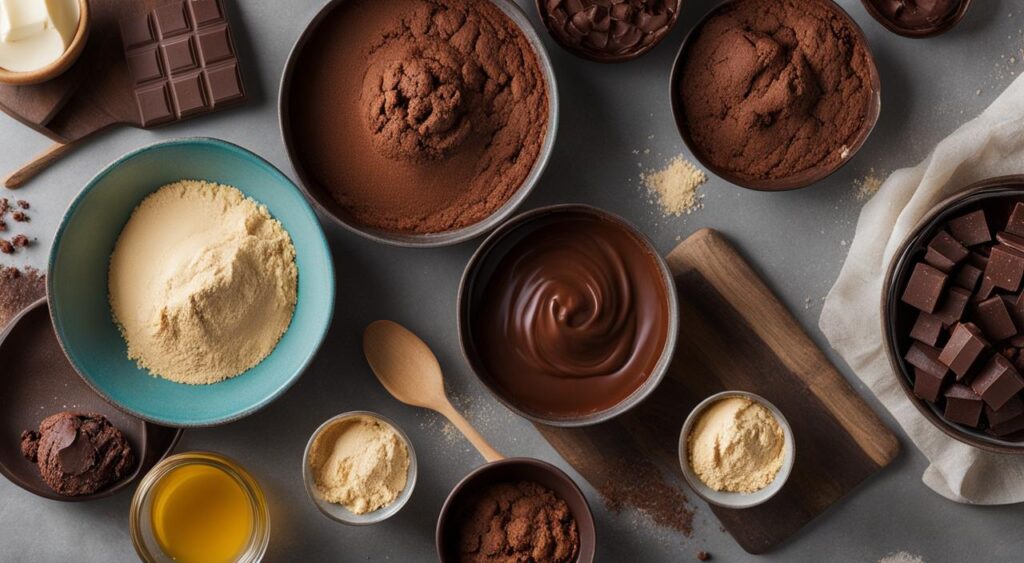
The Folding Method
The folding method is a crucial technique in the biscuit mixing process, essential for creating delicate and tender cookies. This method ensures that ingredients are gently combined, preserving the dough’s airiness. By adhering to the proper steps in a cookie recipe, bakers can achieve cookies with a light texture and refined flavors.
Preparing Ingredients
The first step involves preparing all necessary ingredients as per your chosen cookie recipe. Accurate measurement of ingredients is key to achieving the best results. This preparation phase sets the foundation for a successful mixing process.
Combining Dry Ingredients
Begin by mixing the dry ingredients in a separate bowl. This mix typically includes flour, baking powder, and salt. The separation of dry ingredients helps in achieving an even blend when combined with the wet ingredients.
Mixing Wet Ingredients
In a larger bowl, mix the wet ingredients, which may include butter, sugar, eggs, and flavorings. Whether using an electric mixer or a sturdy wooden spoon, ensure these ingredients are well blended to form a cohesive mixture.
Incorporating Dry into Wet Ingredients
Gradually add the dry ingredients to the wet mixture, taking care to do so slowly and gently. This step is crucial to avoid overmixing and to preserve the dough’s airiness. Sifting the dry ingredients into the wet mixture can help achieve an even distribution.
The Folding Process
With the dry ingredients partially combined with the wet, begin the folding process. Using a soft spatula or a large metal spoon, gently fold the mixture. The technique involves scooping under the mixture, lifting, and then folding it over itself. Rotate the bowl to ensure even incorporation of all ingredients, completing the folding method for perfect cookie dough.
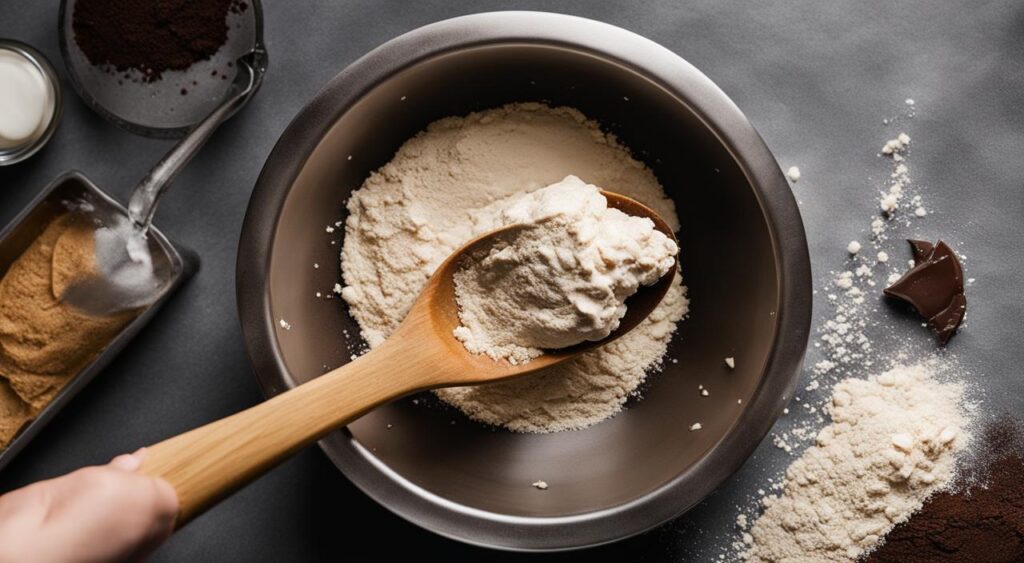
This folding motion keeps the dough light and airy, preventing excessive gluten development and resulting in tender cookies. Avoid stirring or beating the mixture vigorously, as this can lead to tough cookies with an undesirable texture.
Continue folding the mixture until the dry ingredients are fully incorporated, and the dough has a consistent texture and appearance. Take care not to overmix, as this can lead to dense and tough cookies.
Once the folding process is complete, you can proceed to shape the dough into individual cookies or chill it in the refrigerator to enhance the flavors and stabilize the dough before baking. Follow the remaining steps in your cookie recipe for baking instructions.
By mastering the folding method, you can elevate your cookie baking skills and create homemade treats that are sure to impress. Enjoy the light and delicate texture of cookies made using this technique, and experiment with different flavors and add-ins to customize your creations.
Tips for Perfect Cookie Dough Preparation
Preparing perfect cookie dough requires attention to detail and the use of proper techniques. Follow these expert tips to ensure your cookies turn out just right every time.
Mixing Techniques
When it comes to mixing cookie dough, the method you choose plays a significant role in the texture and flavor of your cookies. Here are some essential techniques:
- The Creaming Method: This technique involves beating together the butter and sugar until light and fluffy. It creates a tender and delicate cookie dough.
- The All-in-One Method: This method involves combining all the ingredients at once. It is quick and convenient, but be careful not to overmix, as it can result in tough cookies.
- The Folding Method: Used for delicate cookies, this technique involves gently combining the ingredients to maintain airiness. It is often employed when incorporating whipped egg whites or sifted dry ingredients.
Experiment with different mixing techniques to find the one that yields the best results for your cookie recipe.
Proper Ingredient Incorporation
Properly incorporating the ingredients is crucial for achieving a uniform and well-mixed cookie dough. Consider the following tips:
- Begin by sifting dry ingredients, such as flour, baking powder, and spices. Sifting helps remove any lumps and ensures even distribution.
- Gradually add the dry ingredients to the wet ingredients, mixing just until combined. Overmixing can lead to dense and tough cookies.
- If your recipe calls for adding mix-ins, such as chocolate chips or nuts, fold them into the dough gently to prevent overmixing.
Chilling and Resting
Allowing your cookie dough to chill and rest can greatly improve the texture and flavor of your cookies. Here’s why:
Chilling the dough helps solidify the fats, allowing the cookies to spread less during baking. It also gives the flavors time to meld together, resulting in a more developed taste.
For most cookie recipes, chilling the dough for at least 1-2 hours is recommended. However, some cookie doughs may require longer chilling times, so be sure to follow the instructions in your recipe.
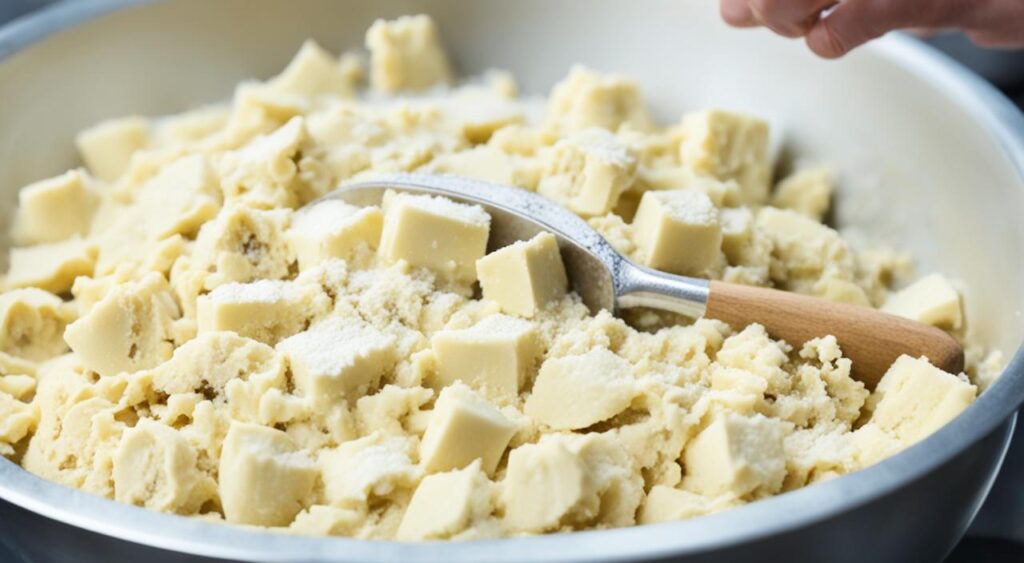
By following these tips and techniques for preparing perfect cookie dough, you’ll be well on your way to baking delicious, homemade cookies with the ideal texture and flavor.
Achieving the Perfect Texture and Flavor
When it comes to baking the perfect batch of cookies, mastering the art of mixing biscuit dough is essential. The way you combine the ingredients can significantly impact the final texture and flavor of your cookies. To help you achieve the best results, we’ve compiled some valuable cookie dough mixing tips. Follow these techniques to enhance the overall taste and texture of your baked treats.
The Creaming Method
The creaming method is a classic technique that involves beating softened butter and sugar together until light and fluffy. This method creates air pockets in the dough, resulting in soft and tender cookies. Remember to start with room temperature butter and beat it with the sugar until the mixture becomes pale and creamy.
The All-in-One Method
If you’re looking for a quick and easy way to mix your cookie dough, the all-in-one method is perfect for you. In this method, all the ingredients are combined at once and mixed until well incorporated. This approach simplifies the process and saves time, making it ideal for busy bakers.
The Folding Method
The folding method is often used for delicate cookie doughs, such as those for macarons or meringue-based cookies. This technique involves gently combining the dry ingredients into the wet ingredients using a folding motion. By folding rather than mixing vigorously, you preserve the airiness of the dough and create light, airy cookies.
Remember, regardless of the mixing method you choose, it’s important not to overmix the dough. Overmixing can lead to tough cookies. Instead, mix until the ingredients are just combined.
Now that you know the best ways to mix biscuit dough, you can experiment with different methods to achieve the perfect texture and flavor in your cookies. Enjoy the process of baking and take delight in the delicious results!
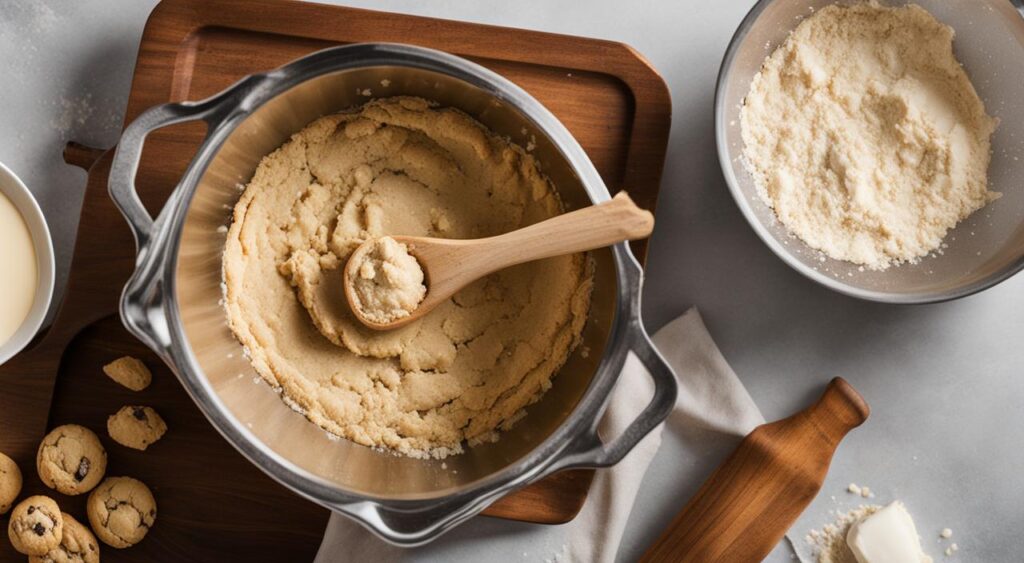
Conclusion
In this article, we have explored the three main methods of mixing cookies biscuits: the creaming method, the all-in-one method, and the folding method. These techniques offer different approaches to achieve the perfect texture and flavor in your cookie dough. For a deeper dive into the intricacies of these methods, including how the creaming method can affect the texture and spread of your cookies, Fat Daddio’s provides a comprehensive overview. They explain how the amount of creaming can influence the final texture of your cookies, ensuring you achieve the desired outcome whether you’re aiming for a cookie that spreads just right or one that maintains a more robust shape.
By employing these mixing techniques for cookies and following our cookie dough mixing tips, you can elevate your baking skills and create delicious cookies that will delight your friends and family. Whether you prefer light and fluffy biscuits or delicate and tender cookies, there is a method suited to your taste. To further refine your technique, consider exploring additional resources such as The Cookie Countess, which discusses the one-stage or one-bowl mixing method, offering a simplified approach for those looking to streamline their baking process.
Remember to pay attention to the details, from properly incorporating butter and sugar for the creaming method to gently folding in the ingredients for the folding method. Each step contributes to the final result.
LOOKING FOR MORE?
- Chicken and Biscuits Recipe
- Almond Flour Biscuits Recipe
- Blueberry Biscuits Recipe
- Gluten-Free Christmas Biscuits Recipe
- White Lily Biscuit Recipe
- Biscuit Recipe No Milk
- Popeyes Biscuits Recipe
- Bojangles Biscuit Recipe
- 3 Ingredient Biscuit Recipe

